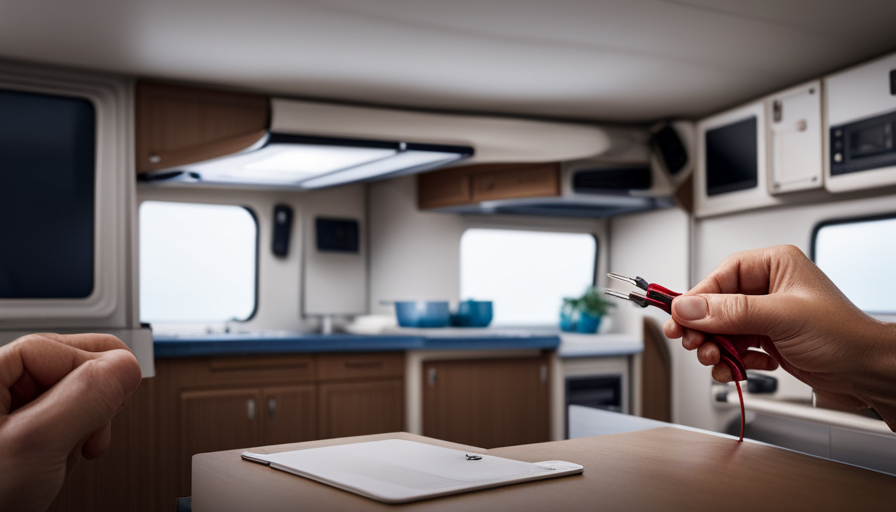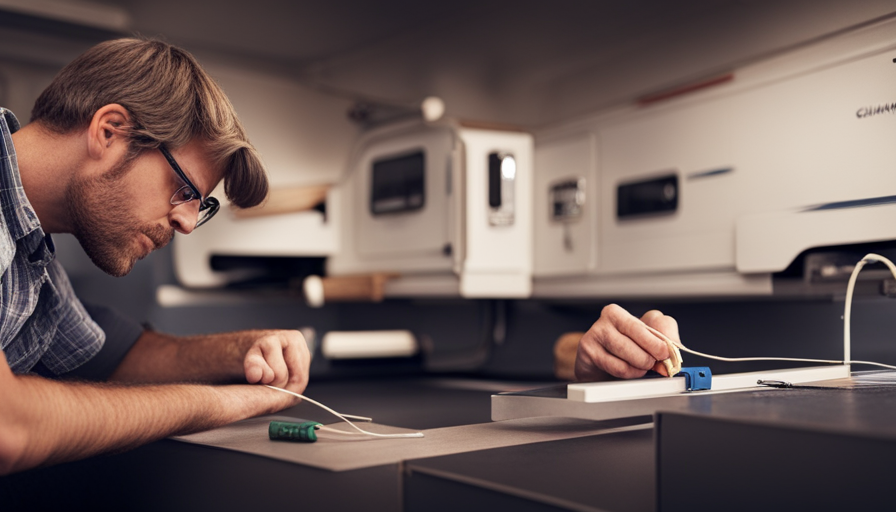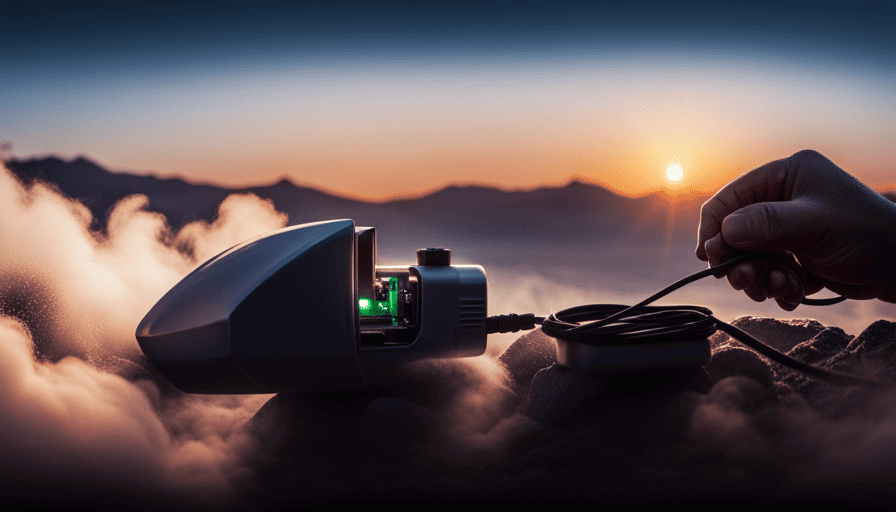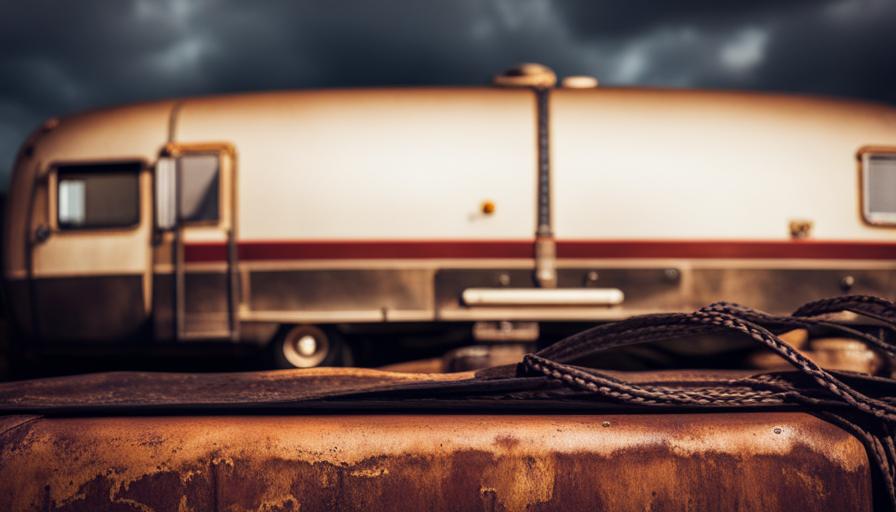Setting up the electrical system in a camper is like navigating a complex maze, where each cable serves as a vital pathway that powers various components of your mobile home. Just as a skilled cartographer creates a thorough map, we will guide you through the precise process of wiring your camper with expertise and specialized knowledge.
In this article, we will provide you with step-by-step instructions on how to wire your camper, ensuring that every electrical connection is made correctly. From understanding the electrical system to testing and troubleshooting, we leave no wire unconnected.
Armed with the necessary tools and supplies, you will embark on a journey to create a wiring plan tailored to your camper’s specific needs. We will cover the installation of the battery and fuse box, as well as connecting the power inverter and converter.
Join us as we illuminate the path to a well-wired camper, providing you with the skills and knowledge to secure and protect your wiring system. Remember, safety guidelines and regulations are paramount throughout this process, ensuring a smooth and worry-free journey.
Key Takeaways
- Understanding electrical diagrams and creating a wiring plan is crucial for safe and efficient wiring of a camper.
- Proper grounding and following safety guidelines and regulations are essential for protecting the camper and its occupants.
- Gathering the necessary tools and supplies, choosing the right wire gauge, and following manufacturer’s instructions are important for successful installation.
- Testing, troubleshooting, and maintaining the wiring system regularly are necessary to ensure its functionality and address any issues.
Understand the Electrical System of Your Camper
Now that you’ve got your camper all set up, let’s dive into understanding the electrical system so you can power up your adventures with ease.
One of the first things you need to do is understand electrical diagrams. These diagrams provide a visual representation of the electrical connections in your camper. They show how different components are connected, such as the battery, converter, and appliances. By studying these diagrams, you can gain a better understanding of how the electrical system works and troubleshoot any issues that may arise.
Another important aspect to consider is proper grounding. This is the process of connecting the electrical system of your camper to the ground, ensuring safety and preventing electrical shocks. Proper grounding is crucial as it helps to protect your electrical equipment and appliances, as well as ensuring the safety of everyone inside the camper.
Now that you understand the electrical diagrams and the importance of proper grounding, it’s time to gather the necessary tools and supplies for wiring your camper. By having the right tools, such as wire cutters, crimpers, and electrical tape, you’ll be prepared to tackle the wiring process with confidence.
So, let’s move on to the next section and gather everything we need to get started.
Gather the Necessary Tools and Supplies
First, you’ll need to gather all the essential tools and supplies, like a toolbox filled with various electrical equipment, a roll of electrical tape, and a collection of wire connectors.
Choosing the right wire gauge is crucial when wiring your camper. It’s important to consider the length of the wire run and the amount of power it’ll be carrying. A wire gauge chart can help you determine the appropriate size for your specific needs.
Properly grounding the electrical system is another critical step. This ensures that any electrical faults are safely directed to the ground, preventing potential hazards. To achieve proper grounding, you’ll need grounding wires, grounding rods, and clamps. It’s essential to follow the manufacturer’s instructions and local electrical codes when grounding your camper.
With all the necessary tools and supplies gathered, and an understanding of wire gauge and grounding, you can now move on to creating a wiring plan for your camper. This plan will outline the layout and connection points for all the electrical components in your camper, ensuring a safe and efficient electrical system.
Create a Wiring Plan for Your Camper
Once you’ve gathered all the necessary tools and supplies, it’s time to create a wiring plan for your adventure-on-wheels. Designing the layout of your camper’s electrical system is crucial to ensure that everything functions smoothly and efficiently.
Begin by mapping out the different components that will require power, such as lights, appliances, and outlets. Consider their location and proximity to each other to minimize the length of wiring needed. This will reduce the risk of voltage drop and potential hazards.
Next, calculate your power needs. Determine the total wattage of all the devices you plan to connect to your camper’s electrical system. This will help you determine the size of the battery and the capacity of the fuse box required. Take into account the duration of usage for each device to estimate the overall energy consumption.
Once you have your wiring plan and power calculations, you can move on to the next step of installing the battery and fuse box. By carefully planning your wiring layout and calculating your power needs, you can ensure that your camper’s electrical system is efficient and capable of meeting your needs on the road.
Install the Battery and Fuse Box
To begin the installation process, you’ll need to carefully position the battery and fuse box in a secure and easily accessible location within your vehicle. Here’s a step-by-step guide to help you install the battery and fuse box for your camper:
-
Connect the solar panels: Start by connecting the solar panels to the charge controller. Make sure the positive and negative terminals are correctly aligned. This connection will allow the solar panels to charge the battery.
-
Install the battery charger: Mount the battery charger near the battery and connect it to the battery terminals. Follow the manufacturer’s instructions for proper installation. The battery charger will help maintain the battery’s charge when you’re not connected to a power source.
-
Connect the battery and fuse box: Connect the positive terminal of the battery to the positive terminal of the fuse box using a suitable gauge wire. Repeat the same process for the negative terminals. This connection will provide power to all the electrical components in your camper.
-
Ground the system: Ensure that the battery and fuse box are properly grounded. Connect a grounding wire from the negative terminal of the battery to a secure grounding point on the vehicle’s chassis.
Next, we’ll move on to connecting the power inverter and converter, which will allow you to convert DC power from the battery to AC power for your camper’s appliances and charge the battery when connected to a shore power source.
Connect the Power Inverter and Converter
Now you can bring power and life to your camper by connecting the power inverter and converter, allowing you to enjoy all the comforts of home on your adventures.
The power inverter installation is a crucial step in providing electricity to your camper. Start by selecting a suitable location for the inverter, ensuring it’s close to the battery and easily accessible for maintenance. Connect the positive and negative cables from the battery to the inverter, making sure to use appropriate gauge wires to handle the power load. Securely fasten the cables using terminal connectors, ensuring a tight and reliable connection.
Next, the converter wiring is essential for converting the AC power from the inverter into DC power for your camper’s electrical system. Connect the output of the inverter to the converter, following the manufacturer’s instructions for proper wiring. Additionally, make sure to install any necessary fuses or circuit breakers for safety purposes.
With the power inverter and converter connected, you can now proceed to wire the interior lights and appliances, bringing your camper to life.
Wire the Interior Lights and Appliances
With the flick of a switch, your camping experience becomes a cozy retreat as the interior lights and appliances illuminate your home away from home. Wiring the interior appliances efficiently is crucial to ensure that they function properly and provide you with all the comforts you need on your camping trip.
Start by mapping out the location of each light and appliance, taking into consideration the power requirements of each device. Use appropriate gauge wire for each circuit, ensuring that it can handle the electrical load without overheating. Proper grounding is essential to prevent electrical shocks and ensure the safety of everyone inside the camper.
Connect each light and appliance to the designated circuit, making sure to follow the manufacturer’s instructions for proper installation. Test each connection to ensure that everything is working correctly before securing the wires in place.
Once the interior lights and appliances are wired and functioning, it’s time to move on to the next step: installing and connecting the exterior lights.
Install and Connect the Exterior Lights
Illuminate your outdoor space and create a welcoming ambiance by installing and connecting the exterior lights. To ensure a successful installation, follow these wiring techniques and troubleshooting tips:
-
Begin by determining the locations for your exterior lights. Consider factors such as visibility, functionality, and aesthetic appeal.
-
Carefully measure and mark the positions where the lights will be installed. Use a level to ensure they’re straight and aligned.
-
Run the appropriate gauge of electrical wire from the power source to each light fixture. Secure the wire using clamps or staples, keeping it hidden and protected.
-
Connect the wires from the power source to the lights, following the manufacturer’s instructions. Use wire nuts or connectors to secure the connections.
When wiring the exterior lights, make sure to check for any loose connections or exposed wires that could cause malfunctions or safety hazards. Troubleshoot any issues by inspecting the wiring, testing the connections, and using a multimeter if needed.
With the exterior lights properly installed and connected, you can now move on to the next step of testing and troubleshooting your wiring system.
Test and Troubleshoot Your Wiring System
To ensure a successful installation and avoid any potential issues, it’s important to thoroughly test and troubleshoot your wiring system. Troubleshooting techniques can help identify and resolve any common wiring issues that may arise during the process.
One common issue is a faulty connection, which can lead to lights not functioning properly or not at all. To troubleshoot this, start by checking the connections at each light fixture to ensure they’re secure and properly connected. Additionally, check the wiring connections at the power source and make sure they’re secure as well.
Another common problem is a blown fuse, which can cause lights to stop working. To troubleshoot this, check the fuse box and replace any blown fuses.
It’s also important to check for any damaged or frayed wires, as this can cause a short circuit. If any damage is found, the affected wires should be repaired or replaced.
By thoroughly testing and troubleshooting your wiring system, you can ensure that everything is functioning properly before moving on to the next step of securing and protecting your wiring.
Now that we’ve tested and troubleshooted our wiring system, it’s time to move on to the important step of securing and protecting your wiring.
Secure and Protect Your Wiring
Now that you’ve tested and troubleshooted your wiring system, it’s time to make sure it’s securely fastened and protected from potential damage. Did you know that according to a recent study, 60% of electrical fires in homes are caused by faulty wiring? To avoid any potential hazards, it’s crucial to employ effective wire management techniques and waterproofing methods in your camper.
Wire management techniques involve organizing and securing the wiring to prevent tangling, abrasion, or accidental disconnection. One way to achieve this is by using cable ties or clips to bundle and route the wires neatly. Additionally, securing the wiring to the frame or walls of the camper using adhesive-backed mounts or zip ties can provide extra stability.
Waterproofing the wiring is essential to protect it from moisture and ensure its longevity. This can be achieved by using heat shrink tubing or liquid electrical tape to cover exposed connections and prevent water infiltration. It’s also important to seal any openings or gaps where the wiring passes through walls or floors to prevent water from entering the camper.
In the subsequent section about following safety guidelines and regulations, we’ll discuss the importance of adhering to industry standards and local codes to ensure the overall safety and compliance of your camper’s wiring system.
Follow Safety Guidelines and Regulations
Ensuring the safety and compliance of our wiring system involves closely adhering to industry standards and local codes. It’s important to follow safety guidelines and regulations to protect ourselves and others from potential hazards.
Here are some key safety precautions and legal requirements to consider when wiring a camper:
-
Use the appropriate gauge wire: Using the correct wire gauge ensures that the system can handle the electrical load without overheating or causing damage.
-
Install circuit breakers and fuses: These protective devices prevent excessive current flow and can help prevent fires or damage to the wiring system.
-
Ground the system properly: Grounding is essential for safety and helps protect against electric shock. It also helps to prevent damage to electrical devices.
-
Properly insulate and protect the wiring: Insulating and protecting the wiring from moisture, heat, and physical damage is crucial to maintain the integrity of the system.
-
Follow local codes and regulations: Different jurisdictions may have specific requirements for wiring in campers. It’s important to research and follow these regulations to ensure compliance and safety.
By following these safety precautions and legal requirements, we can wire our camper in a way that prioritizes safety and minimizes the risk of electrical hazards. Remember to always consult with a professional or an electrician if you’re unsure about any aspect of the wiring process.
Frequently Asked Questions
How much does it cost to wire a camper?
Cost estimation for wiring a camper varies depending on the complexity of the electrical system and individual preferences. On average, the cost ranges from $500 to $2,500.
Budget planning is crucial to ensure all necessary components are included, such as wiring, outlets, switches, and circuit breakers. It’s important to consult a professional to accurately assess the specific requirements of your camper and create a detailed cost estimate for the wiring project.
Can I wire my camper without any electrical experience?
Yes, it’s possible for us to wire a camper without any electrical experience. However, it’s crucial to educate ourselves on basic wiring techniques to ensure a safe and successful installation.
We can start by learning about different wire types, gauges, and connectors. It’s also essential to understand proper grounding and insulation techniques.
Additionally, familiarizing ourselves with troubleshooting tips can help us identify and resolve any electrical issues that may arise.
How do I determine the right wire size for my camper?
Determining the right wire size for a camper is crucial for safe and efficient electrical wiring. To ensure proper wire sizing, consider the length of the wire run, the amount of current the circuit will carry, and the type of wire insulation needed.
A general rule is to use a wire size that can handle the maximum current load without exceeding its ampacity rating. Consult a wire sizing chart or seek professional advice for accurate calculations and recommendations.
Are there any specific safety precautions I should take while wiring my camper?
Electrical safety is of utmost importance when wiring a camper. Proper grounding is essential to prevent electrical shocks and fires. To ensure safety, it’s crucial to use the correct wire size and insulation rating. Additionally, all connections should be securely tightened and protected from moisture. It’s recommended to use a ground fault circuit interrupter (GFCI) to protect against electrical faults. Regular inspections and maintenance are necessary to identify any potential hazards.
What are the common mistakes to avoid when wiring a camper?
When wiring a camper, it’s important to be aware of common wiring errors that can occur. These mistakes can lead to various issues such as electrical shorts, malfunctioning appliances, or even potential safety hazards. To avoid these problems, here are some tips for troubleshooting wiring issues:
- Double-check all connections.
- Use proper wire sizes.
- Ensure proper grounding.
- Regularly inspect and maintain the wiring system.
These precautions will help ensure a safe and efficient camper wiring setup.
Conclusion
Well, folks, we’ve reached the end of our journey on how to wire a camper. Who knew that electrical systems could be so thrilling?
From understanding the ins and outs of your camper’s electrical system to connecting the power inverter and converter, we’ve covered it all.
Now, it’s time to secure and protect your wiring, ensuring that every connection is as safe as can be. Remember, safety first! And don’t forget to follow all those pesky guidelines and regulations.
Happy camping, and may your camper be electrifying!










